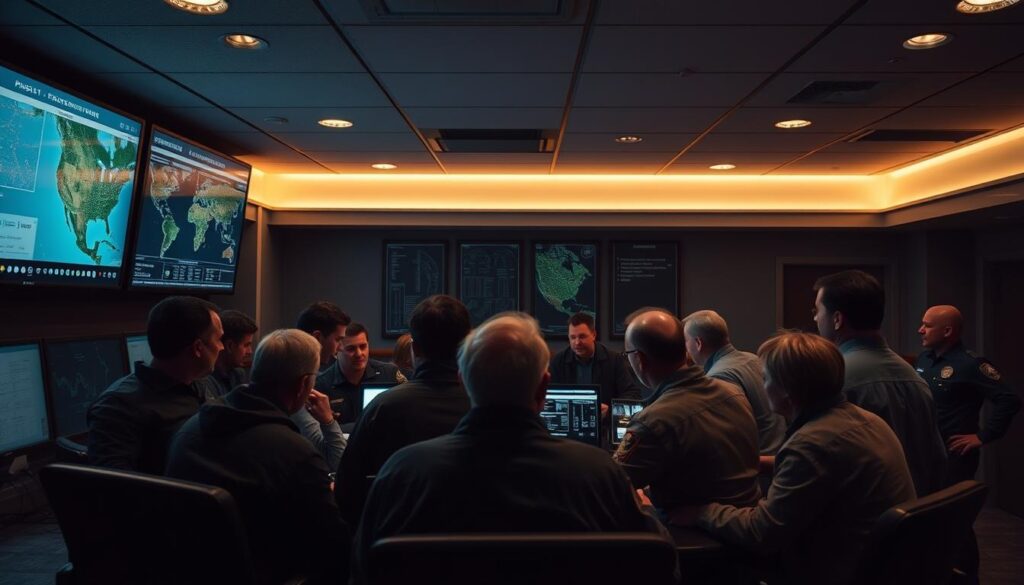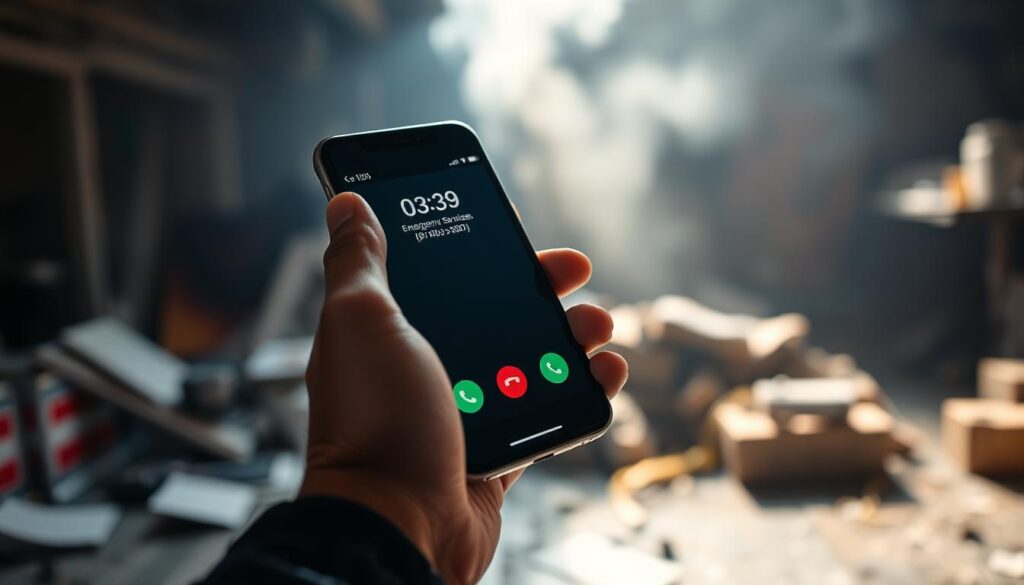Are you prepared to handle unexpected emergency situations that require immediate attention? Whether it’s a flooded house or a sudden leak, responding efficiently is crucial for maintaining your reputation and ensuring client satisfaction.
For a company, providing timely and professional service during an emergency is vital, especially when clients are willing to pay a premium for emergency call-out cover. Establishing an effective system for handling such situations is key to delivering on your service promises and maintaining a competitive edge.
This comprehensive guide will walk you through the process of handling maintenance emergencies, from initial assessment to final billing, ensuring you’re equipped to navigate complex situations with confidence and professionalism.
Key Takeaways
- Understand how to quote emergency call-outs correctly to ensure fair compensation for urgent work.
- Establish an effective emergency response system to handle unexpected situations.
- Assess situations accurately to provide timely and professional service.
- Deliver on your service promises to maintain client satisfaction and reputation.
- Navigate the complexities of emergency service provision with confidence and professionalism.
Understanding Emergency Call-Outs in the UK
When dealing with emergency call-outs in the UK, it’s crucial to understand what constitutes a genuine emergency. As a tradesperson, you’re likely to encounter situations that require immediate attention to prevent damage, injury, or significant disruption to a home or business.
What Constitutes a Genuine Emergency
A genuine emergency typically involves an immediate risk to life, property, or critical business operations that cannot wait for regular service hours. This can include unforeseen circumstances such as fires, floods, gas leaks, or chemical spills that pose a threat to your workplace, employees, customers, or premises.
Common Emergency Scenarios for Tradespeople
Common emergency scenarios include burst pipes, electrical failures, structural damage, and heating system failures during extreme weather. Different industry sectors face unique challenges; for instance, plumbers deal with water damage prevention, while electricians handle dangerous electrical faults. Recognising these situations helps you prioritise resources and set appropriate expectations with clients about response times and costs, addressing the problem effectively.
Setting Up an Effective Emergency Response System
An effective emergency response system requires careful planning and implementation to ensure timely and efficient responses. To achieve this, you need to establish clear protocols, train your team, and utilise appropriate technology.
Creating Clear Emergency Protocols
Clear emergency protocols should outline response times, assessment procedures, communication channels, and decision-making hierarchies. This ensures smooth operations during high-pressure situations.
Training Your Team for Emergency Situations
Comprehensive and ongoing team training is crucial for handling emergency situations effectively. This training should cover technical skills and customer service approaches specific to crisis management, enabling your team to respond professionally.
Implementing Tracking Technology and Telematics
Tracking technology and telematics significantly enhance modern emergency response systems. By identifying the nearest available technician to respond to an emergency in any area, you can reduce response times and improve service efficiency.
To make sure your emergency response system is effective, consider the following key elements: dedicated communication channels that remain operational during widespread emergencies, clear guidelines for prioritising multiple emergency calls based on severity and risk assessment, and regular drills and simulations to test your team’s readiness.
Assessing Emergency Situations Accurately
Emergency situations demand precise assessment to ensure timely resolution. When a client contacts you in a state of panic, it’s crucial to remain calm and gather comprehensive information about the emergency situation.
Initial Information Gathering
Accurate assessment begins with gathering detailed information from the client during the initial call. Developing a standardised set of questions helps ensure you collect all relevant details about the emergency, including potential hazards and the extent of damage.
- Gathering information on the nature and severity of the problem
- Assessing potential risks and hazards
- Understanding the impact on the client’s business or daily life
Determining Priority Levels
Determining priority levels requires balancing multiple factors, including safety risks, potential for further damage, and the vulnerability of occupants. Your assessment should include remote troubleshooting where possible to determine if the situation is truly an emergency.
| Priority Level | Description | Response Time |
|---|---|---|
| High | Immediate risk to safety or significant damage | Within 1 hour |
| Medium | Potential risk or moderate damage | Within 4 hours |
| Low | No immediate risk or minor damage | Within 24 hours |
The knowledge gathered during the initial assessment directly influences resource allocation and response time promises. Accurate assessment prevents both under-responding to genuine emergencies and over-committing resources to non-critical situations.

Calculating Fair Emergency Call-Out Charges
Calculating the right emergency call-out charge requires a delicate balance between urgency and fairness. You need to consider various factors to ensure that your pricing is both competitive and profitable.
Base Call-Out Fees vs Regular Rates
Base call-out fees for emergency work typically include a premium above regular rates to account for the immediate response and out-of-hours service provision. This premium reflects the additional costs associated with emergency call-outs, such as overtime payments to staff and the opportunity costs of diverting resources from scheduled jobs.
For instance, a company might charge a base call-out fee of £50 to £100, which is higher than their regular rate. This fee covers the initial response and assessment, ensuring that customers understand the costs involved in emergency services.
Time-Based Pricing Considerations
Time-based pricing considerations should account for different rates for different times of day, weekends, and public holidays, with transparent tiered pricing structures. You may want to implement a tiered pricing system, where emergency call-outs during peak hours or on weekends incur higher rates.
For example, a plumbing company might charge:
| Time of Day | Rate (£/hour) |
|---|---|
| Monday to Friday, 9am-5pm | 60 |
| Evenings and Weekends | 90 |
| Public Holidays | 120 |
Additional Factors Affecting Emergency Quotes
Additional factors affecting emergency quotes include travel distance, parts availability, complexity of the job, potential hazards, and whether the maintenance issue could have been prevented. You should also consider the true cost of emergency work, including wear and tear on vehicles and equipment.
For instance, a longer travel distance may incur additional charges to cover fuel costs and time. Similarly, if the job requires specialized parts, you may need to factor in the cost of sourcing these parts urgently.
To maintain transparency and fairness, it’s essential to document your emergency pricing structure clearly and consistently apply it across your company. Consider offering emergency service plans or maintenance contracts that provide discounted emergency call-out rates in exchange for regular preventative maintenance commitments.
Quoting Emergency Call-Outs Correctly to Clients
Quoting emergency call-outs correctly is vital for maintaining transparency and trust with your clients. When an emergency arises, your clients need reassurance that you’re handling the situation effectively.
To achieve this, your staff should be fully trained to identify the problem and carry out a fix immediately, or at least provide a recommendation. Providing a rough estimated range of repair costs helps manage client expectations.
Managing Client Expectations During Crisis
Managing client expectations during a crisis requires balancing honesty about the severity of the problem with reassurance about your ability to fix it effectively. For instance, if a client experiences a burst pipe, you should explain the urgency of the situation while assuring them of your capability to resolve the issue promptly.
Providing Clear and Transparent Quotes
When providing quotes during emergencies, make sure to explain the breakdown of costs, including call-out fees, labour rates, parts, and any additional charges that may apply. For business clients, emergency quotes should address both immediate fix costs and potential business continuity implications to help them make informed decisions. You can visit https://www.myjobquote.co.uk/costs/emergency-plumbing for more information on emergency plumbing costs.
Transparent quoting practices should include providing a range rather than a fixed price when the full extent of the problem cannot be determined until work begins. Documenting client approval of emergency quotes is essential for avoiding disputes.
| Quote Component | Description | Example Cost |
|---|---|---|
| Call-out Fee | Initial fee for emergency visit | £50-£100 |
| Labour Rate | Hourly rate for work done | £75-£150/hour |
| Parts and Materials | Cost of materials used for repair | Variable |
| Additional Charges | Any extra costs for urgency or complexity | £20-£100 |

Delivering on Your Emergency Service Promise
Emergency situations demand a swift and effective response from your company. Delivering on your emergency service promise means more than just arriving on time; it encompasses having the right tools and parts to fix the issue efficiently.
Maintaining Professionalism Under Pressure
In the midst of an emergency situation, maintaining professionalism is crucial. Your technicians should remain calm, focused, and solution-oriented, even when dealing with complex issues or distressed clients. This not only resolves the immediate problem but also reinforces client trust in your company’s capabilities.
Documenting Work and Adjusting Quotes When Necessary
Clear documentation during emergency call-outs is vital for both warranty purposes and building your company’s knowledge base. If the scope of work changes, transparent communication about necessary adjustments to quotes is essential to protect both your business and client relationships. Providing follow-up support after emergency repairs demonstrates your commitment to client satisfaction and offers opportunities to discuss preventative maintenance strategies.
| Aspect of Emergency Service | Description | Benefit |
|---|---|---|
| Professionalism Under Pressure | Technicians remain calm and focused | Reinforces client trust |
| Clear Documentation | Thorough records of work done | Supports warranty and knowledge base |
| Transparent Communication | Adjustments to quotes communicated clearly | Protects business and client relationships |
By focusing on these aspects, you can ensure that your emergency service not only addresses the immediate issue but also provides a durable solution, saving time and enhancing client satisfaction in the long run.
Conclusion: Building Trust Through Reliable Emergency Services
Establishing a robust emergency response system is essential for providing reliable services and building trust with your clients. By having effective systems in place, you can ensure that your team is equipped to handle emergency situations efficiently. This not only enhances your reputation but also fosters client loyalty.
Prevention should be a key part of your business model, complemented by maintenance programs that help clients avoid emergency situations. By understanding clients’ needs and exceeding their expectations, you can deliver on your emergency service promises and strengthen your business reputation.



